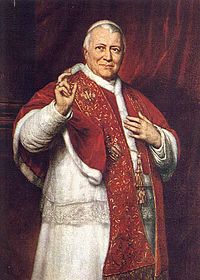Portal:Vatican City
Vatican City Portal
 |
|
Vatican City is an ecclesiastical or sacerdotal-monarchical state, ruled by the Bishop of Rome—the Pope. This makes the Vatican the only remaining absolute monarchy in Europe. The highest state functionaries are all clergymen of the Roman Catholic Church. It is the sovereign territory of the Holy See (Sancta Sedes) and the location of the Pope's residence, referred to as the Apostolic Palace.
Vatican City was established as an independent state in 1929 by the Lateran Treaty, signed by Cardinal Secretary of State Pietro Gasparri, on behalf of Pope Pius XI and by Prime Minister Benito Mussolini on behalf of King Victor Emmanuel III of Italy. The treaty spoke of it as a new creation (Preamble and Article III), not as a vestige of the much larger Papal States (756–1870) that had previously encompassed much of central Italy. Vatican City State is distinct from the Holy See, which dates back to early Christianity and is the main episcopal see of 1.2 billion Latin and Eastern Catholic adherents around the globe. Ordinances of Vatican City are published in Italian; official documents of the Holy See are issued mainly in Latin.
Selected panorama
Selected article
The palace is more accurately a series of self-contained buildings within the well-recognised outer structure which is arranged around the Courtyard of Sixtus V (Cortile di Sisto V). It is located North-East of St Peters Basilica and adjacent to the Bastion of Nicholas V and Palace of Gregory XIII.
Rather than a traditional palace (a residential building surrounded by support buildings) the Apostolic Palace houses both residential apartments and support offices of various functions as well as administrative offices not focused on the life and functions of the Pope himself.
The building contains the Papal Apartments, various government offices of the Roman Catholic Church and the Holy See, private and public chapels, Vatican Museums and the Vatican library, including the Borgia Apartment now used to house artworks.
Selected picture
Vatican during the Savoyard Era 1870-1929 describes the relation of the Vatican to Italy, after 1870, which marked the end of the Papal State and 1929, when the papacy regained autonomy in the Lateran Treaty.
In the news
Did you know?
- ... that Bishop Aloisius Muench, the liaison between the Vatican and the U.S. post-war occupation authority in Germany, referred to the latter as "other Hitlers in disguise"?
- ...that Pope Pius XII's retention of Cesare Orsenigo (pictured left, with Hitler and von Ribbentrop) as Apostolic Nuncio to Germany is a "chief point of criticism" of his response to the Holocaust?
- ...that Clemente Micara was the Vatican’s first envoy to Czechoslovakia?
Things to do
 |
Here are some tasks awaiting attention:
|
-
-
-
- –When a task is completed, please remove it from the list.
-
-
Related portals
WikiProjects
Featured content
The restoration of the frescoes of the Sistine Chapel was one of the most significant art restorations of the 20th century. The Sistine Chapel was built by Pope Sixtus IV within the Vatican immediately to the north of St. Peter's Basilica and completed in about 1481. Its walls were decorated by a number of Renaissance painters who were among the most highly regarded artists of late 15th century Italy, including Ghirlandaio, Perugino, and Botticelli. The Chapel was further enhanced under Pope Julius II by the painting of the ceiling by Michelangelo between 1508 and 1512 and by the painting of the Last Judgment, commissioned by Pope Clement VII and completed in 1541, again by Michelangelo. The tapestries on the lowest tier, today best known from the Raphael Cartoons (painted designs) of 1515–16, completed the ensemble.
Together the paintings make up the greatest pictorial scheme of the Renaissance. Individually, some of Michelangelo's paintings on the ceiling are among the most notable works of western art ever created. The frescoes of the Sistine Chapel and in particular the ceiling and accompanying lunettes by Michelangelo have been subject to a number of restorations, the most recent taking place between 1980 and 1994. This most recent restoration had a profound effect on art lovers and historians, as colours and details that had not been seen for centuries were revealed.
Read more...
Categories
Wikimedia
External Resources
- What are portals?
- List of portals
- Featured portals









